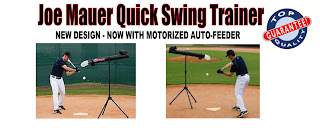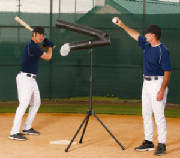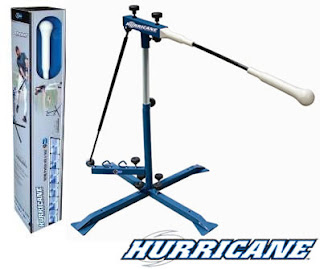 www.BatAction.com
www.BatAction.comBy
Ed Bagley Sometimes as parents we forget how simple and subtle the lessons in life can be.
I was reminded of this yesterday afternoon when I heard the cheering of youngsters playing a Little League baseball game in the nearby city park. It is amazing when the noise of kids at play can carry the sound a half-block away and into the open window of your living room.
Little League baseball games can get noisy. Kids are excited when the bases are loaded and their next hitter sends a screaming line drive into the outfield.
They know that the outfielder will likely boot the ball, and as it gets by him on its merry way to the fence, all three players on base will score and the hitter will probably come home safe with an inside-the-park home run and 4 ribbies (runs batted in) to his credit.
Ah, baseball, spring is in the air and summer is approaching.
The pure fun of sport is so normal and so natural to our human experience.
I read a study once that interviewed hardened criminals spending life in prison for capital crimes, such as murder. A psychologist asked inmates what they missed most now that they were spending the rest of their lives behind bars without possibility of parole.
The answer stunned me, and it should stun you too. What they missed most was not their girlfriend, or sex, or drinking, or drugging, or gambling; it was the sound of kids playing. Perhaps the one, real, positive memory they have of their life was when they were a child playing.
These are two compelling extremes: children at play without a care in the world, and incarcerated criminals who are burdened with the reality that they will never again be free to play.
With all of the violence we are now seeing with youngsters who solve their supposed "problems" by shooting their perceived "enemies" (many times friends and family), I am reminded that some of our children today seem less able to cope with adversity, and even less so with patience.
How is it that they clearly lack coping skills and patience, two necessary traits for survival as an adult?
It will take someone a lot smarter than me to give you the right answer to this question.
I will leave that answer to what some educated professionals who study psychology think.
In the meantime, I choose not to tell you what I think, but to share with you what I know.
Here is one thing about Little League baseball that is being taught by some parents and some leaders in some organizations that is really not worth teaching, and that is this:
Certain organizations have adopted the misguided practice of rewarding every kid on each team regardless of their effort or performance. In other words, a team can lose every game all year and each kid gets a trophy for participating, a team picture and his or her own baseball card with their mug on it.
Apparently some parents do not want to hurt their child's feelings even though the child makes little effort, is clearly incompetent at improving on any skills of the game, does not understand the game, and really could care less.
I doubt the parents in the example given have a clue about the lessons they are teaching their children by insisting on this foolish practice of making their child feel like he or she has accomplished something.
First, they are encouraging mediocrity by rewarding nothingness. Practice this stupidity a few more generations and we will have our children thinking they can show up to work as an adult, do nothing and get paid for their lack of skills, effort and production.
Second, they are rewarding children for having no concept of goal-setting and achieving goals. The parents are not encouraging any concept of self-improvement and providing no incentive to do so.
Third, they are teaching no learning skills in how to cope with failure, and not providing a shred of understanding about the function of failing. Losers would be astonished to learn that successful people have failed more than losers ever thought of failing.
One of the big differences between losers and winners in the game of life is that when winners fail, they get right back up, dust themselves off, learn from the experience, and try again.
Fourth, they devalue the kids who do work hard, fail and then succeed by rewarding a bunch of kids who haul off and do nothing, learn nothing, and have no sense of real accomplishment.
I remember going door-to-door as a 9-year-old kid, looking for a sponsor for a baseball team I was putting together. I instinctively knew kids would want to be on my team if I could get them a free baseball hat and shirt; we would then look like a real team. I had played on a team that had nothing; we could not afford uniforms, we were lucky to have a glove or borrow a glove.
I found that sponsor, a business called Jewell Realty in Flint, Michigan. I found a sponsor because I was looking for a sponsor. The people that owned that business were impressed that a 9-year-old kid would have the guts to walk all over town and ask businesses to sponsor his rag-tag team. I put up with the nos and getting kicked out of places because I wanted it that bad.
The year was 1953 and we were terrible; we lost more games than we won. We were put upon, put down, slapped around and got the crap kicked out of us, but I never quit, and I made sure my teammates didn't quit either. When someone quit trying, I kicked him off the team and found someone else.
Two years later we won the league championship, and when we did, I was surrounded by winners who had become my friends. I did not need my parents to do this for me, I did not need some meddling adult or juvenile counselor to do this for me, I needed to do this for myself.
When I got the guys together and we took that trophy down to Jewell Realty, we all shared in the excitement of being winners. Later that summer I would walk by Jewell Realty, see that trophy in the window, and know who I was and what I had become: a winner. Jewell Realty did not win that trophy, I won that trophy, and I knew what it would take to win another.
Our parents never saw us play, they were too busy working.
If someone had come around after that first season and given each of us a trophy for losing, we would not have accepted it. Think about it: the message they would have been sending us was we think you are so bad that you could never win a title, so in order to sooth your precious little feelings, here is a trophy for being a loser.
I think I would have spit in their face. I was that competitive. I might have been a 9 year old but I did not need some meddling parent setting goals for me that I thought were so low I would trip on them walking across the baseball diamond.
If you think a 9-year-old child cannot have some dignity, you are dead wrong, and have probably been wrong about a lot of things in your life.
Once we won that championship and experienced our moment of victory, you could have taken that trophy away and it would not have mattered. I knew what I had sacrificed to win that trophy, and after all of the blood, sweat and tears, nothing any stupid parent or adult could do would have made me feel less about myself. I knew I was a winner, and I wasn't going to settle for anything less.
Parents, if you do not understand one thing in raising your children, understand this: if your child goes through his or her entire schooling period (kindergarten through high school graduation) and never experiences real success at anything at least one day is his or her life, your child will be handicapped for life. Nothing could be more arcane, stupid and bovine.
Don't you dare try to prevent your child from failing. Let them try and when they fail, pick them up, dust them off, and encourage them to try again. It is in failing that we learn to succeed.
If you as a parent cannot be a winner in your own pathetic life, if all you have to offer is whining and complaining about this and that, and bemoaning how your child is treated, then get the hell out of the way and let your child fail to ultimately win on his own.
Take a snapshot of two pictures.
In one a child is given a trophy, a team photo and a baseball card with his picture on it featuring a loser who accomplished nothing. In the other snapshot, a child is given only a trophy, or the team is given one trophy to admire, because they have worked their butts off, improved their skills, played their hearts out, taken risks and won a league title. Which is your child?
Any child who has worked to get to the top of the mountain, and experiences the sheer joy of competing and winning, is someone who will go much farther in life.
I can tell you from experience in hiring that there is an incredible correlation between having athletic success at the high school or college level and success later in life. The reason is simple: winners win and losers don't.
Do not misunderstand what I am sharing here. It is not that you cannot win bigger and better in life unless you are a successful athlete in your youth, it is that you need to have a sense of accomplishment and recognition doing something that takes hard work, dedication, effort and goals. It could be singing, it could be acting, it could be playing a musical instrument; suffice to say any activity that allows you to fail, learn, improve and succeed over a period of time.
It certainly helps to have a strong father in the house to help teach his children what it is to be a winner, to learn coping skills, patience, hard work, dedication, effort, improvement and success. A strong single mother can do the same.
Do not play patty-cake with your children when they are 9 years old, do not knowingly set them up in life to fail, let them struggle and succeed. If you do not do this someday they will be adult and not know how to act when they are put down, put upon, made fun of and beaten up emotionally. They will figure it out if you do not protect them and their feelings so much they become helpless and inept.
They will learn to cope and be stronger for the experience. When they reach adulthood they will be able to dismiss people around them who have mediocre minds and are mental midgets. They will be polite as they treat these losers as irrelevant (which they are) and be unaffected by their negative presence.
Then they will move on quickly to be with the winners. It is the losers who are left standing alone and wondering why.
Do not play to participate, play to win. It is not winning that is the be all to end all, it is that in the process of winning we learn important skills that make us much more effective in playing and winning in the game of life. After all, life is not a resting place; life is a testing place, it is now and will continue to be as long as you live.
A wise man said it and it bears repeating here: When everyone is somebody then no one's anybody.
Copyright © 2007 Ed Bagley
Ed Bagley's Blog Publishes Original Articles with Analysis and Commentary on 5 Subjects: Sports, Movie Reviews, Lessons in Life, Jobs and Careers, and Internet Marketing. My intention is to inform, educate, delight and motivate you the reader.
Read my articles on "Facts About the Second Most Controversial Topic in America - The First Is Abortion", "So Why Should I Subsidize Any Banks Because of Their Greed and Incompetence?" and "Self-Improvement - Here Are My Personal Favorite Quotes That I Live By, Learn By and Grow By".
Find my Blog at:
http://www.edbagleyblog.comhttp://www.edbagleyblog.com/LessonsinLife.htmlArticle Source:
http://EzineArticles.com/?expert=Ed_Bagley ===Advertisement from our sponsor:=====
 Baseball2u.com
Baseball2u.com/
CoachesBest.com is the ultimate online baseball training annd coaching store. With over 1400 products organized into categories
Baseball2u.com makes finding that baseball training product easy and simple. Order securely online or by phone.
Baseball2u.com is a fully licensed company and has a full time staff available from 8:00 to 5:00 CST. Their toll free customer service number is 1-877-431-4487.
The Categories they have are:
Baseball Training Equipment,
Youth Baseball Training Equipment,
Training Bats,
Pitching & Throwing Trainers,
Defensive Trainers,
Batting Cages,
Pitching Machines,
Jugs Equipment,
Game and Practice Baseballs,
Protective Practice Screens and Nets,
Portable Pitching Mounds,
Baseball DVDs & Books,
Clearance Items on Sales,
BatAction Hitting Machines,
Hurricane Hitting Machines,
NEDCO Bataction Replacement Parts,
SKLZ Hurricane Replacement Parts and Much Much More! Visit
Baseball2U.com today!















